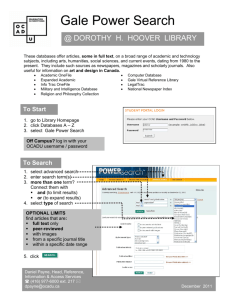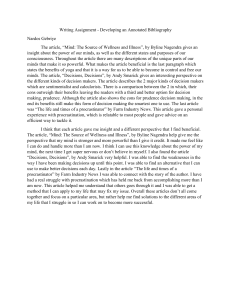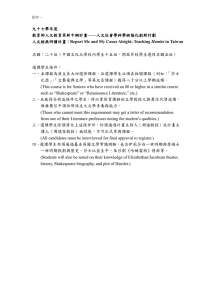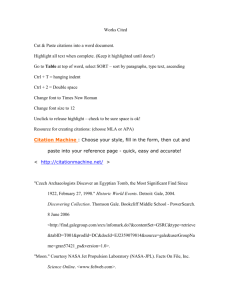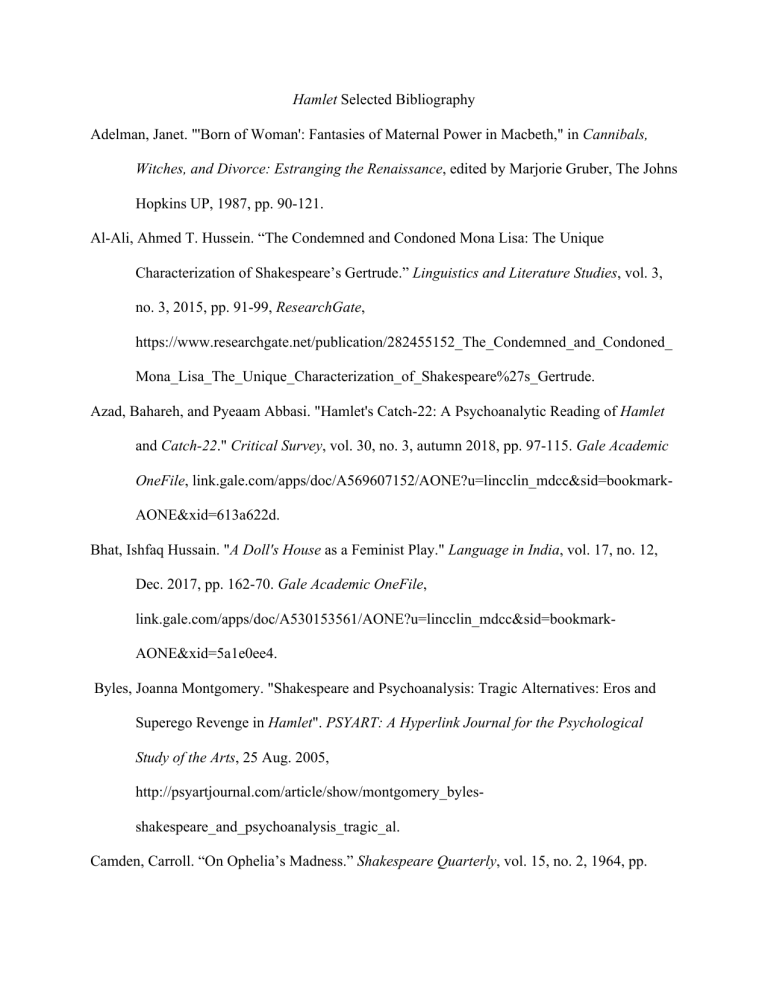
Hamlet Selected Bibliography Adelman, Janet. "'Born of Woman': Fantasies of Maternal Power in Macbeth," in Cannibals, Witches, and Divorce: Estranging the Renaissance, edited by Marjorie Gruber, The Johns Hopkins UP, 1987, pp. 90-121. Al-Ali, Ahmed T. Hussein. “The Condemned and Condoned Mona Lisa: The Unique Characterization of Shakespeare’s Gertrude.” Linguistics and Literature Studies, vol. 3, no. 3, 2015, pp. 91-99, ResearchGate, https://www.researchgate.net/publication/282455152_The_Condemned_and_Condoned_ Mona_Lisa_The_Unique_Characterization_of_Shakespeare%27s_Gertrude. Azad, Bahareh, and Pyeaam Abbasi. "Hamlet's Catch-22: A Psychoanalytic Reading of Hamlet and Catch-22." Critical Survey, vol. 30, no. 3, autumn 2018, pp. 97-115. Gale Academic OneFile, link.gale.com/apps/doc/A569607152/AONE?u=lincclin_mdcc&sid=bookmarkAONE&xid=613a622d. Bhat, Ishfaq Hussain. "A Doll's House as a Feminist Play." Language in India, vol. 17, no. 12, Dec. 2017, pp. 162-70. Gale Academic OneFile, link.gale.com/apps/doc/A530153561/AONE?u=lincclin_mdcc&sid=bookmarkAONE&xid=5a1e0ee4. Byles, Joanna Montgomery. "Shakespeare and Psychoanalysis: Tragic Alternatives: Eros and Superego Revenge in Hamlet". PSYART: A Hyperlink Journal for the Psychological Study of the Arts, 25 Aug. 2005, http://psyartjournal.com/article/show/montgomery_bylesshakespeare_and_psychoanalysis_tragic_al. Camden, Carroll. “On Ophelia’s Madness.” Shakespeare Quarterly, vol. 15, no. 2, 1964, pp. 247–55. JSTOR, https://www.jstor.org/stable/pdf/2867895.pdf?refreqid=excelsior%3Ae235f2d53ceef7928 cc8cdf5648d64be&ab_segments=&origin=&initiator=&acceptTC=1. Chamberlain, Stephanie. "Fantasizing Infanticide: Lady Macbeth and the Murdering Mother in Early Modern England." Shakespearean Criticism, edited by Michelle Lee, vol. 110, Gale, 2008. Gale Literature Criticism, https://link.gale.com/apps/doc/A135022676/SUIC?u=olla123&sid=bookmarkSUIC&xid=6e074283. Originally published in College Literature, vol. 32, no. 3, Summer 2005, pp.123-125. Chan, Sumie. “Gender and Literature – Is Gender Gendered? Female Protagonists in Macbeth (1606), Thelma and Louise (1991) and A Doll’s House (1879) – Three Different Genres of Literature across Centuries.” International Journal of Languages, Literature and Linguistics, vol. 7, no. 4, Dec. 2021, pp.189-92. The Hong Kong University of Science and Technology SPD: The Institutional Repository, https://repository.hkust.edu.hk/ir/bitstream/1783.1-112612/1/112612.pdf. Chapman, Alison A. “Ophelia’s ‘Old Lauds’: Madness and Hagiography in Hamlet.” Medieval & Renaissance Drama in England, vol. 20, 2007, pp. 111–35. Gale Academic OneFile, https://link.gale.com/apps/doc/A169311540/AONE?u=lincclin_mdcc&sid=bookmarkAONE&xid=3989ebfc. Daalder, Joost. "Shakespeare's Attitude to Gender in Macbeth." Shakespearean Criticism, edited by Michelle Lee, vol. 57, Gale, 2001. Page 1-22. Gale Literature Criticism, link.gale.com/apps/doc/MYNURJ217873364/LCO?u=olla123&sid=bookmark-LCO&xid =85599643. Davis, Marion A. "A Brief Look at Feminism in Shakespeare's Macbeth." Inquiries Journal/Student Pulse vol. 1, no.11, 2009, http://www.inquiriesjournal.com/a?id=1691. Ferguson, Lisa. Lady Macbeth and Gertrude: A Study in Gender. 2002. Western Kentucky U, Masters thesis, http://digitalcommons.wku.edu/theses/656. Gao, Yang. “A Feminist Approach to The Great Gatsby.” International Journal of Frontiers in Sociology, vol. 3, no. 6, pp. 42-46. Semantic Scholar, https://api.semanticscholar.org/CorpusID:252335549. Gates, Sarah. “Assembling the Ophelia Fragments: Gender, Genre, and Revenge in Hamlet.” Explorations in Renaissance Culture, vol. 34, no. 2, 2008, pp. 229–47, https://doi.org/10.1163/23526963-90000358. Günenç, Mesut. “Ophelia and Gertrude: Victimized Women in Hamlet.” The Journal of International Social Research vol. 41, 2015, pp. 164-164. Gurr, Andrew. "The Claudian Globe." Shakespearean Criticism, edited by Michelle Lee, vol. 44, Gale, 1999. Gale Literature Criticism, link.gale.com/apps/doc/ABTQVZ382658391/LCO?u=olla123&sid=bookmarkLCO&xid=0cb1c671. Originally published in Hamlet and the Distracted Globe, Sussex UP, 1978, pp. 26-41. Habib, Imtiaz. "'Never Doubt I Love': Misreading Hamlet." College Literature, vol. 21, no. 2, June 1994, pp. 19-32. Gale Academic OneFile, link.gale.com/apps/doc/A15691719/AONE?u=lincclin_mdcc&sid=bookmarkAONE&xid=086aab4e. Accessed 25 Jan. 2023. Harding, D. W. “Women’s Fantasy of Manhood: A Shakespearian Theme.” Shakespeare Quarterly, vol. 20, no. 3, 1969, pp. 245–53. JSTOR, https://www.jstor.org/stable/pdf/2868376.pdf?refreqid=excelsior%3A7f05ec43df05ccb70 96772f3f15e54ef&ab_segments=&origin=&initiator=.. Heine, Erik. "Controlling and Controlled: Ophelia and the Ghost as Defined by Music in Grigori Kozintsev's Hamlet." Literature-Film Quarterly, vol. 37, no. 2, Apr. 2009, pp. 109-23. Gale Academic OneFile, link.gale.com/apps/doc/A198941682/AONE?u=olla123&sid=bookmarkAONE&xid=c6503be0. Hyun, Sarah. “The Great Gatsby through the Lens of Feminism.” English 100, taught by Pr. Whitley, Lehigh University, 19 Dec. 2018, https://wordpress.lehigh.edu/ssh419/2018/12/19/great-gatsby-through-the-lens-offeminism/. Jajja, M. Ayub. “A Feminist Reading of Shakespearean Tragedies: ‘Frailty, Thy Name Is Woman.’” Pakistan Journal of Commerce and Social Sciences (PJCSS), vol. 8, no. 1, 2014, pp. 228-237. Econstor, http://hdl.handle.net/10419/188135. Jiajia, Yuan. “An Analysis of Gatsby's American Dream in The Great Gatsby from the Perspective of Lukacs.” Academic Journal of Humanities & Social Sciences, vol.4, no. 9, 10 Nov. 2021, pp. 131-135, Francis Academic Press Digital Library, https://francispress.com/uploads/papers/jaXLuX63JBA4IEZtbGOrm02BQFIu00qPfRUzQUsy.pdf. Janton, Pierre. “Sonship and Fatherhood in Macbeth.” Cahiers Elisabethains, vol. 35, April 1989, pp. 47-58. Jenkins, Harold. "Fortinbras and Laertes and the Composition of Hamlet." Rice Institute Pamphlet-Rice University Studies, vol. 60, no. 2, Apr. 1974, pp. 95-108. Rice Digital Scholarship Archive, https://scholarship.rice.edu/bitstream/handle/1911/63151/article_RIP602_part6.pdf?seque nce=1&isAllowed=y. Joseph, Miriam. “Hamlet, a Christian Tragedy.” Studies in Philology, vol. 59, no. 2, 1962, pp. 119–40. JSTOR, http://www.jstor.org/stable/4173378. Jorgensen, Paul A. Our Naked Frailties: Sensational Art and Meaning in Macbeth. U of California P, 1971. Kimbrough, Robert. "Macbeth: The Prisoner of Gender." Shakespearean Criticism, edited by Michael Magoulias and Marie Lazzari, vol. 29, pp. 127033. Gale, 1996. Gale Literature Criticism, link.gale.com/apps/doc/LOWMGR511633215/LCO?u=olla123&sid=bookmarkLCO&xid=68192f9c. Originally published in Shakespeare Studies, vol. 16, 1983, pp. 175-190. Klett. Elizabeth. “Reading between the Lines: Connecting with Gertrude and Ophelia in William Shakespeare’s Hamlet (ca. 1600).” Women in Literature: Reading Through the Lens of Gender, edited by Jerilyn Fisher and Ellen S. Silber, Greenwood P, 2003, pp. 130-33. Kranz, David L. “The Sounds of Supernatural Soliciting in Macbeth.” Studies in Philology, vol. 100, no. 3, Summer 2003, pp. 346-383. JSTOR, https://www.jstor.org/stable/4174762. Lawrence, William Witherle. “Hamlet and Fortinbras.” PMLA, vol. 61, no. 3, Sep. 1946, pp. 673-698. JSTOR, http://www.jstor.com/stable/459241. Leonard, Kendra Preston. “Silencing Ophelia: Male Aurality as a Controlling Element in Olivier's Hamlet.” Scope: An Online Journal of Film and Television Studies, vol. 14, June 2009, https://www.nottingham.ac.uk/scope/documents/2009/june-2009/leonard.pdf. Lidz, Theodore. Hamlet's Enemy: Madness and Myth in Hamlet. Basic Books, 1975. Liston, William T. “‘Male and Female Created He Them’: Sex and Gender in Macbeth.” College Literature, vol. 16, no. 3, 1989, pp. 232–39. JSTOR, http://www.jstor.org/stable/25111824. Louden, Bruce. “Telemachos, the Odyssey and Hamlet.” Text & Presentation, 2014, edited by Graley Herren, McFarland, 2014, pp. 33-50. The Comparative Drama Conference Series, 11. Love, H. W. “Seeing the Difference: Good and Evil in the World of Macbeth.” Australasian Universities Language and Literature Association Journal (AUMLA), vol. 72, 1989, pp. 203-28. Mason, Tricia. “Hamlet and His Foils: Fortinbras and Laertes.” Owlcation, 18 July 2022, https://owlcation.com/humanities/Shakespeares-Hamlet-Foils-Fortinbras-Laertes. Montgomery, Abigail L. "Enter Queen Gertrude Stage Center: Re-Viewing Gertrude as Full Participant and Active Interpreter in Hamlet." South Atlantic Review, vol. 74, no. 3, summer 2009, pp. 99-117. Gale Academic OneFile, link.gale.com/apps/doc/A301283615/AONE?u=olla123&sid=bookmarkAONE&xid=4bd79857. Mallers, Melanie H. “Father-Son Relationships.” in Poisonous Parenting: Toxic Relationships Between Parents and Their Adult Children, edited by Shea M. Dunham et al., Taylor & Francis Group, 2011, pp. 119-44. ProQuest Ebook Central, http://ebookcentral.proquest.com/lib/mdc/detail.action?docID=735304. Murphy, Brett E. "Sulphurous and Tormenting Flames: Understanding the Ghost in Hamlet." Shakespeare in Southern Africa, vol. 26, annual 2014, pp. 117-22. Gale Academic OneFile, link.gale.com/apps/doc/A387827066/AONE?u=olla123&sid=bookmarkAONE&xid=5e2e926f. Nardo, Anna K. “Hamlet, ‘A Man to Double Business Bound.’” Shakespeare Quarterly, vol. 34, no. 2, 1983, pp. 181–99. JSTOR, https://doi.org/10.2307/2869833. Neely, Carol Thomas. "Documents in Madness: Reading Madness and Gender in Shakespeare's Tragedies and Early Modern Culture." Shakespearean Criticism, edited by Joseph C. Tardiff, vol. 19, Gale, 1993. Gale Literature Criticism, link.gale.com/apps/doc/LABFIF523542483/GLS?u=olla123&sid=bookmarkGLS&xid=9c73f4b6. O'Leary, Niamh J. "Ambition and Desire: Gertrude as Tragic Hero in Feng Xiaogang's The Banquet (2006)." The Upstart Crow, vol. 31, 2012, pp. 63-80. Gale Academic OneFile, link.gale.com/apps/doc/A323037687/AONE?u=olla123&sid=bookmarkAONE&xid=27e70f40. O’Mahoney, Paul. “Ophelia’s Madness: A Suggested Stage Direction.” The Shakespeare Newsletter, vol. 64, no. 1, summer 2014, pp. 28-30. Gale Academic OneFile, link.gale.com/apps/doc/A397453782/AONE?u=lincclin_mdcc&sid=bookmarkAONE&xid=f0d3742b. Rebecca Pancoast, “Morality and Gender: Feminist Interpretations of Macbeth.” Macbeth Study Guide, Ceder Crest College Humanties Department, https://www2.cedarcrest.edu/academic/eng/lfletcher/macbeth/papers/rpancoast.htm. Peterson, Kaara. "Framing Ophelia: Representation and the Pictorial Tradition." Mosaic: A Journal for the Interdisciplinary Study of Literature, vol. 31, no. 3, Sept. 1998, pp. 1-24. Gale Academic OneFile, link.gale.com/apps/doc/A21240449/AONE?u=olla123&sid=bookmarkAONE&xid=d5a66e9a. Pollard, Tanya. GreekTtragicWwomen on Shakespearean Stages. Oxford, 2017. Rahman, Muhanmmad Safiur. “‘Frailty, Thy Name is Woman’–How Frail are Women in the World of Shakespeare? IiUC Studies, vol. – 3, Dec. 2006, pp. 31-44. Bangladesh Journals Online, https://www.banglajol.info/index.php/IIUCS/article/view/2630/2245. Rani, Zamila Abdul et al. “Discovering Feminism through Gertrude and Ophelia in Shakespeare’s Hamlet.” Proceeding of the 2nd International Conference on Economics & Banking 2016 (2nd ICEB), May 24–25, 2016, pp. 247-52. ResearchGate, https://www.researchgate.net/publication/305734925_DISCOVERING_FEMINISM_TH ROUGH_GERTRUDE_AND_OPHELIA_IN_SHAKESPEARE%27S_HAMLET. Reid, Robert L. “Macbeth’s Three Murders: Shakespearean Psychology and Tragic Form,” in Renaissance Papers 1991, edited by George Walton Williams and Barbara J. Baines, The Southeastern Renaissance Conference, 1992, pp. 75-92. Reyes, Camila and Amy Kenny. “Shakespeare’s Violent Women: A Feminist Analysis of Lady Macbeth.” UC Riverside Undergraduate Research Journal, vol. 14, no. 1, pp. 81-85. eScholarship, https://escholarship.org/uc/item/43v335x5. Ronk, Martha C. "Representations of Ophelia." Criticism, vol. 36, no. 1, winter 1994, pp. 21-43. Gale Academic OneFile, link.gale.com/apps/doc/A608188309/AONE?u=olla123&sid=bookmarkAONE&xid=dce51f50. Accessed 25 Jan. 2023. Samons, Loren. “Noble Minds and Nymphs: The Tragic Romance of Hamlet and Ophelia.” CLA Journal, vol. 6, 2018, pp. 12-21. Docslib, https://docslib.org/doc/11639989/noble-mindsand-nymphs-the-tragic-romance-of-hamlet-and-ophelia. Schiffer, James. “Macbeth and the Bearded Women.” In Another Country: Feminist Perspectives on Renaissance Drama, vol. 10, edited by Dorothe Kehler and Susan Baker, Scarecrow P., 1991, pp. 205-17. Internet Archive, https://archive.org/details/inanothercountry0000unse/page/n5/mode/2up. Singh, Rahul. "Shakespeare's Plays: Men Celebrated, Women Despised?" Language in India, vol. 14, no. 2, Feb. 2014, pp. 141-56. Gale Academic OneFile, link.gale.com/apps/doc/A361943037/AONE?u=lincclin_mdcc&sid=bookmarkAONE&xid=ca2674fe. Tomko, Seth. “Analyzing Fortinbras as a Foil for Hamlet.” Owlcation, 1 Aug. 2022, https://owlcation.com/humanities/Fortinbras-as-a-Foil-for-Hamlet. Wagner, Linda Welshimer. “Ophelia: Shakespeare’s Pathetic Plot Device.” Shakespeare Quarterly, vol. 14, no. 1, 1963, pp. 94–97. JSTOR, https://doi.org/10.2307/2868164. White, R. S. “The Tragedy of Ophelia.” Ariel: A Review of International English Literature, vol. 9, no. 2, 1 Apr. 1978, https://journalhosting.ucalgary.ca/index.php/ariel/article/view/32269/26326. Wilber, Jennifer. “The Madness of Hamlet and Ophelia: Mental Illness in Shakespeare.” Owlcation, 6 July 2022, https://owlcation.com/humanities/The-Madness-of-Hamlet-andOphelia-Mental-Illness-in-Shakespeare. Wilson, Jeffrey R. "The Fortunes of Fate in Hamlet: Divine Providence and Social Determination." The Midwest Quarterly, vol. 62, no. 1, fall 2020, pp. 10-26. Gale Academic OneFile, link.gale.com/apps/doc/A644718251/AONE?u=olla123&sid=bookmark-AONE&xid=f86 2ad9f. Wiśniewska, Dorota J. “Supernatural Agents of the Unconscious Mind: The Gothic Mode in Hamlet and Macbeth.” Acta Universitatis Lodziensis. Folia Litteraria Anglica, vol. 5, 2002, pp. 183-91, The Central European Journal of Social Sciences and Humanities, http://hdl.handle.net/11089/14412. Young, Sandra. "Recognising Hamlet." Shakespeare in Southern Africa, vol. 26, 2014, pp. 1326. Gale Academic OneFile, link.gale.com/apps/doc/A387827061/AONE?u=olla123&sid=bookmarkAONE&xid=df5f4be9. Zysk, Jay. “In the Name of the Father: Revenge and Unsacramental Death in Hamlet.” Christianity & Literature, vol. 66, no. 3, 2017, pp. 422–43, Gale Academic OneFile, link.gale.com/apps/doc/A693017867/AONE?u=lincclin_mdcc&sid=bookmarkAONE&xid=cd675fd2.
